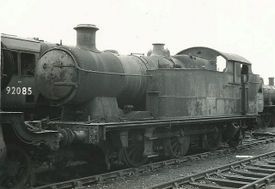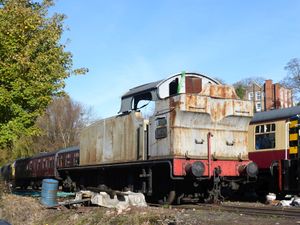GWR 5600 class 6634
| GWR 5600 class 6634 | |
|---|---|
 6634 at Barry Scrapyard in 1968 | |
| Built By | GWR Swindon Works |
| Configuration | 0-6-2T |
| Power class | GWR: D, BR: 5MT |
| Axle load class | GWR: Red |
| Status | Unrestored |
| Loco Number | 6634 |
| History | |
| Built | 1928 |
| Designed By | Charles Collett |
| Type | GWR 5600 |
| 2009 | Arrived on SVR |
| 2017 | Left SVR for Peak Rail |
| Technical | |
| Weight | 69t 7cwt |
| Tractive effort | 25,800 lb |
| Pressure | 200 lb/sq in |
The GWR 5600 Class is a class of 0-6-2T steam locomotive designed by Collett and built between 1924 and 1928. They were based on the Rhymney Railway 1904 M class and 1909 R class locomotives. In 1923 the GWR absorbed a variety of locomotives from pre-Grouping Welsh railway companies, many of 0-6-2T configuration, and built two hundred locomotives of the 5600 class to replace part of that fleet. Numbered in the 5600 and 6600 series, most were built at Swindon, however 6650-6699 were built by Armstrong Whitworth in Newcastle-upon-Tyne. The last of the class remained in service until the end of BR(WR) steam in 1965. The class was not used on the Severn Valley Branch in service due to its 'Red' axle weight classification, although one was allowed to work a coal train to Alveley Colliery by mistake. The class was however used on trains for Stourport Power Station.[1]
Nine of the class have survived into preservation, of which 5619 has also appeared on the SVR.
Contents
6634 in service
6634 was built at Swindon in August 1928 to lot number 252, and withdrawn from Pontypool Road shed in April 1964.[2] It was sent to Barry Scrapyard in August of that year.
6634 in preservation
6634 left Barry in June 1981, the 131st locomotive to do so, initially to the East Somerset Railway.[3][4] It is owned by The Waterman Railway Heritage Trust.
On 19 August 2009 the ‘rolling chassis’ arrived on the SVR for restoration from ex-Barry condition to be completed. SVR News announced that the SVR had reached an agreement with the owners to complete the overhaul of the ‘bottom end’ while Crewe completed the repair of the boiler. The SVR would then bring the locomotive into use with it being run on the SVR for ‘a period deemed fair by both parties’. The deal appeared favourable to the SVR as it would not involve the boiler shop or require space in the works on the jacks. Work was subsequently carried out by the SVR for a period after its arrival.
In 2010 it was reported boiler repairs were going well at LNWR Crewe, but by 2011 plans had changed and they were instead intending to use the boiler of 'Large Prairie' 4115, one of the “Barry Ten”. In Summer 2012 the boiler tubeplate was stolen from Crewe Heritage Centre with serious disruption to progress.[5] By 2014 the SVR reported that there was no progress or commitment on the boiler and the SVR was seeking legal advice concerning the continued lack of progress in order to resolve this long running problem.[6][7]
Peak Rail’s Press Release 12 May 2015 announced: “Dr Pete Waterman OBE DL is delighted to announce that he has reached an agreement with Peak Rail to base his Waterman Railway Heritage Trust assets at its Rowsley site”.[8] Two of its locomotives were moved, but 6634 remained at the SVR.
The locomotive was transported by road from Bridgnorth to Peak Rail on 10 November 2017.[9] The 2017 SVR(H) accounts included a £65k settlement from the Waterman Railway Heritage Trust[10].
See also
Former Residents
The Waterman Railway Heritage Trust
Classes of locomotives used on the Severn Valley Branch in commercial service
References
- ↑ Booth, A., 'CEGB, Stourport Power Station', Railways in Worcestershire (Retrieved 20 November 2020)
- ↑ BRDatabase
- ↑ Railuk.info Barry Scrapyard Search Results
- ↑ Duggan, J., 'GWR 56XX Class steam locomotives – Class Information', Rail Advent, 30 October 2018 (Retrieved 16 August 2020)
- ↑ SVRLive Steam Loco Situation - Summer 2012
- ↑ SVRLive News update 19 February 2014
- ↑ SVRLive News update 4 July 2014
- ↑ Peak Rail Facebook 12 May 2015
- ↑ SVRA Forum, accessed 10 November 2017
- ↑ Minutes of the SVR(H) AGM held on 16 June 2018, Para. 4
Links
GWR 5600 Class on Wikipedia
GWR 5600 Class on Great Western Archive
| ||||||||||||||||||||||||||||||||||

